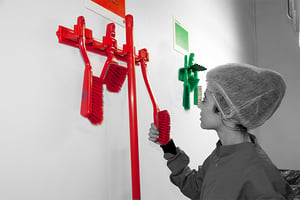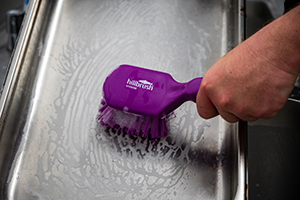In October 2021, Natasha’s law will be legally binding, meaning that businesses that produce and pack foodstuff on site not complying with its content can be prosecuted by the Food Standards Agency. More importantly, businesses affected are now legally required to be clear about what is inside their product within the packaging kept by the consumer.
 This law change is aimed at products packaged that don’t yet have full ingredients and allergens descriptions, PPDS foods or pre-packed directly for sale.
This law change is aimed at products packaged that don’t yet have full ingredients and allergens descriptions, PPDS foods or pre-packed directly for sale.
It came into place due to the tragic death of Natasha Ednan-Laperouse, and the relentless fight of her parents, as well as other campaigners, to ensure information about allergens are added to all packaged foods purchased, offering key data needed to warn and save lives of hypersensitive consumers.
The need for the law is clear and, on the surface, it is all about printing information on labels, but this change hits a level of control much deeper and necessary. It gives food businesses the perfect opportunity to carry out a thorough review of allergen management strategies, including cleaning, cross-contamination hazards, and the level of ownership each member of staff must have to ensure consumer safety is always in front of mind.
Food safety and management
With the well-known challenges posed by Coronavirus restrictions, businesses have had to make tough decisions regarding expenditures, improvement plans and staffing levels. Many companies are working with minimal personnel structure and areas such as cleaning can be seen as less of a priority in contrast to the very important return of customers and volume produced.
Situations where staff are now covering many different functions, can unfortunately lead to cleaning procedures not being followed as documented and sometimes not properly understood. Companies re-engaging with cleaning contractors may find that team members have changed and the level of experience in cleaning can be varied.
These obstacles may have a deep influence in how food safety is managed, and day-to-day control of allergens is handled.
An important area of allergen management is making sure segregation is achieved between the storage of ingredients and finished product on to sale to consumers; this is easier said than done! Allergens found in flour or dairy for example, are proteins that can travel via air, water and through contact with product, equipment, and people.
How cleaning is undertaken is key to ensuring that allergens are controlled in specific areas and every step of the process.
Re-starting operations can also mean a re-set of systems, behaviours and activities carried out on site, giving businesses the perfect opportunity to improve its business and product safety culture. Revising the cleaning regimes so that staff and cleaners are fully understand the risks associated with allergens in food production is extremely important.
My advice is to review each activity from the receipt of ingredients, storage prior to use, to how the product is handled prior to consumption. Using visual aids such as flowcharts can be useful to pin down areas where different allergens can mix, as well as non-allergenic ingredients.
Write down all the controls that are in place (eg wipe down a surface with a cloth once food has been prepared, prior to cooking any non-allergenic food), question if the control is sufficient (e.g. is that cloth then used again? Is there a chance that the cloth is spreading allergens? Are different colours used to aid employees in keeping tools separate?) and make changes to procedures if deemed necessary. When questioning current procedures, consider any new suppliers, new ingredients introduced, new equipment used to produce or store food, new staff or even new type of consumers. Even seemingly irrelevant changes may have a direct effect on how product safety is managed.
 Cleaning activities must be given special attention to ensure segregation is respected as well. Cleaning procedures must consider each allergen as a specific hazard, to ensure products with less allergens are as protected as non-allergenic products. Management of cleaning tools, colour coding equipment, sometimes even separate sinks are beneficial to create an environment where it is second nature to handle allergens and non-allergens as separate food.
Cleaning activities must be given special attention to ensure segregation is respected as well. Cleaning procedures must consider each allergen as a specific hazard, to ensure products with less allergens are as protected as non-allergenic products. Management of cleaning tools, colour coding equipment, sometimes even separate sinks are beneficial to create an environment where it is second nature to handle allergens and non-allergens as separate food.
Processing equipment are traps for allergens so reviewing cleaning tools is crucial. Simple tools such as baking trays can transfer contamination if not cleaned properly between different products.
Once cooking, packing and cleaning have been reviewed, it is crucial that employees are re-trained against latest changes. Involving employees in the review process can bring great benefits as they can share useful details of their activities and help facilitate training as they have been part of the need for change process.
Every training session should be recorded and if possible, provide a visual summary of the changes in each work area so any doubt can be clarified. Supervisors should be given a more in-depth training so they can answer any queries arising from employees, regarding allergens and how to control them.
Staff considerations
If using external cleaning contractors to carry out cleaning, similar preparation is recommended but full involvement and agreement from the contractor is vital to the success in keeping to a standard. Contractors should deliver initial allergen training to all their employees, so when they start work they have the basic understanding of why allergen control is so important. Regardless of whether contracted cleaners have received training prior to arriving on site, I would strongly recommend to carry out a training session explaining specific requirements of the site, any unique ways of handling allergens and what to do if any problems arise. In this situation, it is also important to have visual aids to remind cleaners of colour coding tools, and rules the site may have, as many workers may have limited understanding of English and they may visit many sites or outlets carrying out similar jobs.
It is important to remind staff (internal or external) that, unlike microorganisms like bacteria, allergens are not destroyed by cooking. Once in the food, allergens will remain there, so avoiding contamination is the only way of protecting consumers’ health.
Handling of food is as important as cleaning the environment, as cross-contamination can happen from one food to another. When advising employees to use gloves when touching ingredient, one must remember that gloves may need to be replaced if an allergen is touched prior to moving to another ingredient. Some ingredients may have allergens that will not be obvious (e.g. sulphites in picked vegetables) so labelling of ingredients’ containers is fundamental.
It is worth checking how air circulation takes place to ensure ventilation systems don’t become a place for allergens to gather and later re-circulate.
Keeping communication open with employees will allow the business to find out how much they know about allergens, if they are doing things differently and if yes, can the system be improved again?
Ensure that allergens handled and not handled on site are visible to all and this list must be reviewed with any introduction of product or ingredient, to confirm it is up-to-date.
When businesses have done all that is possible to prevent cross-contamination but there is still a risk of it taking place, this should be reflected on the advice within the label, allowing the consumer to make an informed decision whether they can consume such products.
Raising standards
Certain sectors of the food industry have very well-established systems for allergen management and lessons can be taken from the work already carried out, ensuring that the food industry can raise standards in manufacturing, packaging and supply of foodstuff, as well as providing the public with meaningful and helpful information about hazards present in their products.
When looking at these lessons, one must start with suppliers of ingredients/products and how reliable their services are. Business should have a methodical approach on approving suppliers based on how they manage food safety, if the site has accreditation against recognised food safety standards, any history of ingredients issues between other requirements.
Suppliers of services will also have an input such as cleaning providers, and monitoring of its services can offer evidence that cleaning is done at expected standard and product safety is being maintained.
To confirm correct usage of ingredients, another lesson is to carry out traceability exercise on ingredients in use throughout the year, to ensure the site can trace where all the volume purchased.
Validation of cleaning is an activity focused on confirming that the way cleaning is carried out can achieve the expected outcome and can the done consistently. In this case the expected standard is the removal of allergens from surfaces. This activity can be a great tool to give reassurances that allergens are being controlled properly and that the business has done everything possible to ensure labelling information provided to consumers is correct and according to legal responsibilities.